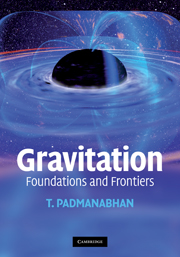Book contents
- Frontmatter
- Contents
- List of exercises
- List of projects
- Preface
- How to use this book
- 1 Special relativity
- 2 Scalar and electromagnetic fields in special relativity
- 3 Gravity and spacetime geometry: the inescapable connection
- 4 Metric tensor, geodesics and covariant derivative
- 5 Curvature of spacetime
- 6 Einstein's field equations and gravitational dynamics
- 7 Spherically symmetric geometry
- 8 Black holes
- 9 Gravitational waves
- 10 Relativistic cosmology
- 11 Differential forms and exterior calculus
- 12 Hamiltonian structure of general relativity
- 13 Evolution of cosmological perturbations
- 14 Quantum field theory in curved spacetime
- 15 Gravity in higher and lower dimensions
- 16 Gravity as an emergent phenomenon
- Notes
- Index
7 - Spherically symmetric geometry
Published online by Cambridge University Press: 05 June 2012
- Frontmatter
- Contents
- List of exercises
- List of projects
- Preface
- How to use this book
- 1 Special relativity
- 2 Scalar and electromagnetic fields in special relativity
- 3 Gravity and spacetime geometry: the inescapable connection
- 4 Metric tensor, geodesics and covariant derivative
- 5 Curvature of spacetime
- 6 Einstein's field equations and gravitational dynamics
- 7 Spherically symmetric geometry
- 8 Black holes
- 9 Gravitational waves
- 10 Relativistic cosmology
- 11 Differential forms and exterior calculus
- 12 Hamiltonian structure of general relativity
- 13 Evolution of cosmological perturbations
- 14 Quantum field theory in curved spacetime
- 15 Gravity in higher and lower dimensions
- 16 Gravity as an emergent phenomenon
- Notes
- Index
Summary
Introduction
In this chapter we will obtain the simplest of the exact solutions to Einstein's equations, which are the ones with spherical symmetry. The chapter also discusses the orbits of particles and photons in these spacetimes and the tests of general relativity. All of this will be used in the study of black holes in the next chapter.
Metric of a spherically symmetric spacetime
One of the simplest – but fortunately very useful – class of solutions to Einstein's equations is obtained when the source Tik and the resulting metric possess spherical symmetry. We shall first obtain the general form of the metric in the spherically symmetric context and then use Einstein's equations to relate the metric to the source. While the form of the spherically symmetric metric (given in Eq. (7.12) below) can be obtained almost ‘by inspection’, we shall perform a rather formal analysis in order to illustrate a useful technique.
If the spacetime exhibits a particular symmetry which can be characterized by the action of an element of a group, then the functional change in the form of the metric under the action of this element of the group should vanish. In the case of spherical symmetry, the relevant group is the group of rotations under which the Cartesian coordinates will change by xa → xa + ξa, where ξa has the components
Here εαβ = −εβα is a set of arbitrary infinitesimal constants (with only three elements being independent due to the antisymmetry) which describe infinitesimal rotations.
Information
- Type
- Chapter
- Information
- GravitationFoundations and Frontiers, pp. 293 - 339Publisher: Cambridge University PressPrint publication year: 2010
